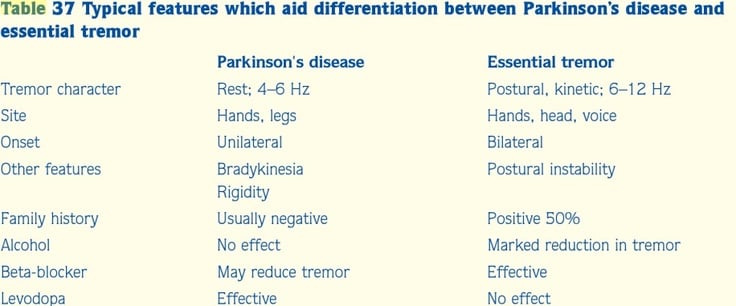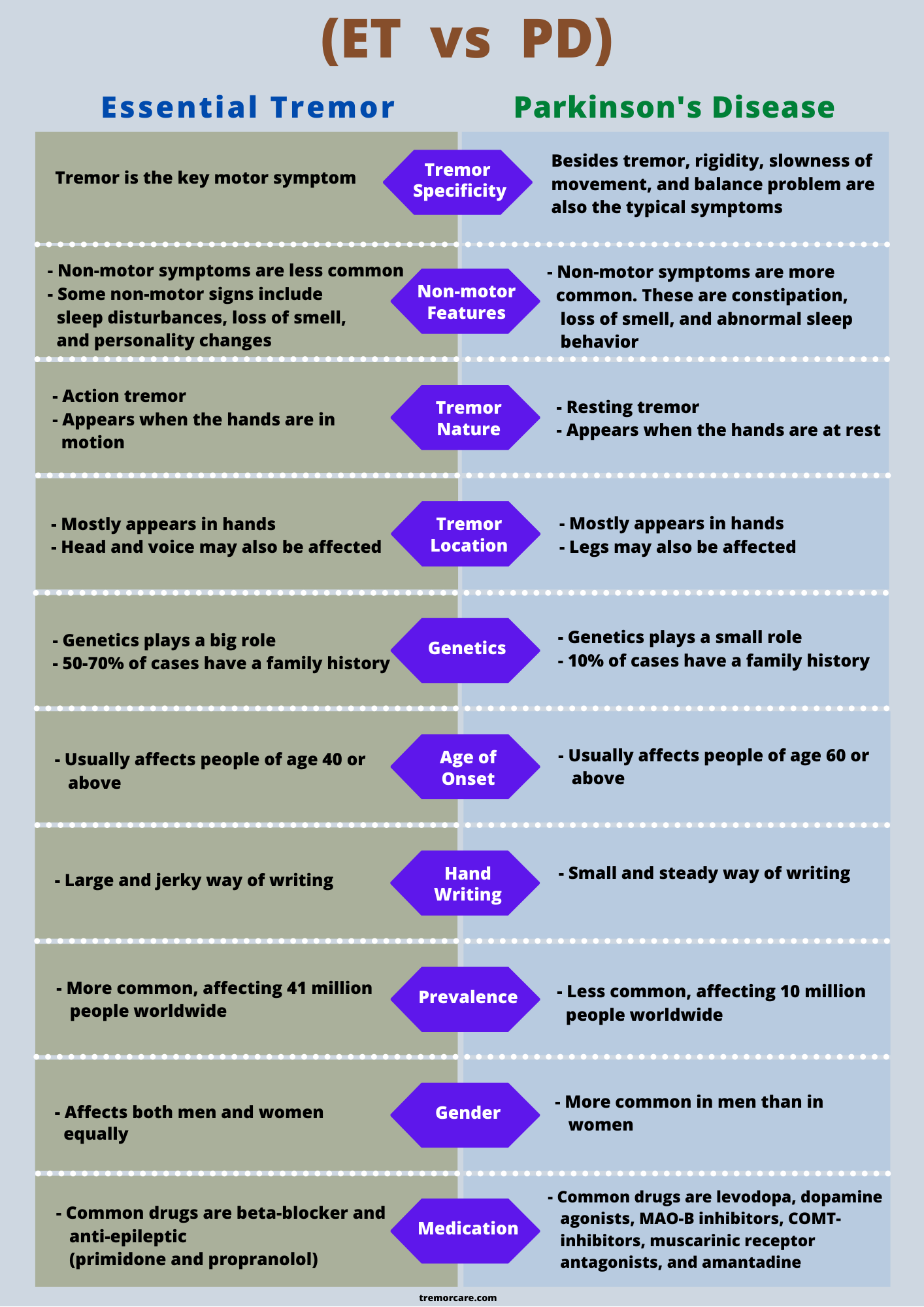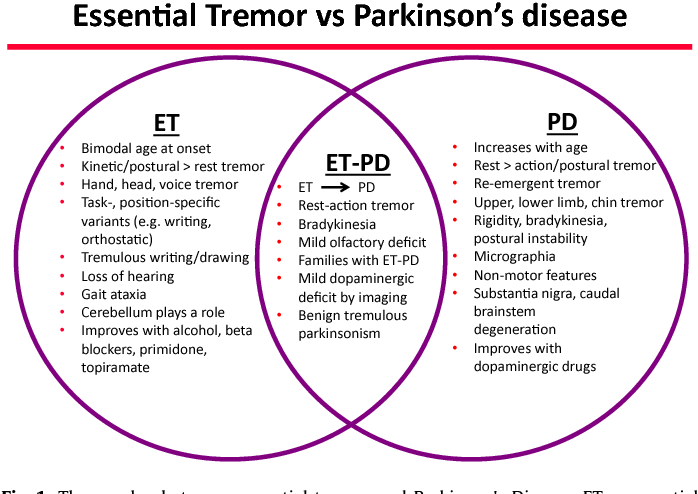Treatments For Parkinsons Disease
While currently available Parkinsons treatments cannot slow or halt the disease, they can help manage symptoms. According to the American Parkinson Disease Association, here are some of the most common treatment options:
There are also lifestyle changes that you can make to help with your Parkinsons symptoms, including:
- Practicing strength training to help with movement
- Stretching to help with rigidity
- Getting massages to relieve muscle stiffness and stress
- Eating a healthier diet to help with lethargy
While these are the most commonly recommended treatment options for Parkinsons disease right now, there is a lot of effort and financial support toward finding new solutions, including clinical trials of medications.
Diagnosing Parkinsons Vs Essential Tremor
The difference between essential tremor and Parkinsons can be so slight that it can be difficult for doctors to diagnose these conditions correctly. In fact, they are often mistaken for one another, which can be frustrating for physicians and patients alike. Specialty physicians that diagnose and treat these conditions are Movement Disorder Neurologists.
While there are no official tests for either condition, there are several diagnostic techniques that physicians employ to attempt properly diagnose essential tremor vs. Parkinsons, including:
- Physical examination: During a physical examination, a physician evaluates the patients motor skills to help in their determination of whether they suffer from essential tremor vs. Parkinsons.
- DaTscan: During a DaTscan, a radioactive tracer is injected, which makes its way into the brain, where it attaches to dopamine transporters. Special imaging scans are then conducted to see whether the dopamine system is healthy. If it is irregular, it may help diagnose your condition as Parkinsons.
- Handwriting sample evaluation: A doctor may be able to differentiate Parkinsons vs. essential tremor using a handwriting sample because those with Parkinsons typically exhibit exceptionally small handwriting, whereas those with ET exhibit larger, shaky handwriting.
The Difference In The Prevalence
Essential tremor is more common than Parkinsons tremor. There are approx 41 million people worldwide are living with this condition. The current estimate shows that 4 out of 100 individuals over the age of 40 are affected by essential tremor.
The number of people suffering from Parkinsons disease is estimated to be 10 million. The statistic shows that around 4 percent of people with Parkinsons are diagnosed before the age of 50.
Also Check: Zhichan Capsule
Resting Tremor Vs Action Tremor
Tremor is categorized into two main classifications: resting tremor and action tremor.
Resting tremor refers to shaking that occurs when a persons muscles are relaxed or at rest. For example, a person may experience a resting tremor in their hands when the persons hands are resting in their lap. Resting tremor only affects a persons hands or fingers .
Action tremor includes tremor that accompanies a persons voluntary movement, such as walking or moving the arms. Most tremors are considered to be action tremors and fall under various subcategories:
- Postural tremor: occurs when a person attempts to maintain a position against the force of gravity, such as holding their arms outstretched.
- Kinetic tremor: accompanies voluntary movement like blinking or moving hands.
- Intention tremor: occurs when moving toward a target and worsens as a person nears their target, like touching the face with a hand or reaching for an object.
- Task-specific tremor: manifests itself when an individual tries to perform a task involving skill or precision, such as handwriting or speaking.
- Isometric tremor: accompanies voluntary muscle contractions that are not associated with movement, as when holding a dumbbell or other heavy object.
Treatments For Essential Tremor

According to Harvard.edu, there are several actions that can be taken to help manage your essential tremor and minimize how they impact your daily life. First, lets cover treatment options:
As each patient is different, you and your doctor will need to decide what the best course of action is for you. You must weigh the pros and cons of each treatment option based on your lifestyle and how you think theyll impact your quality of life.
You May Like: On Off Phenomenon
Demographic And Clinical Characteristics
Essential tremor and PD patients were similar in age, gender, education, handedness, caffeine intake, and use of medications with potential tremor-inducing properties . As expected, ET patients had longer tremor duration and were less likely to have undergone deep brain stimulation surgery than PD patients . ET patients also exhibited more severe tremor than PD patients in their Archimedes spiral drawings .
Tremors Yes Parkinson’s Disease No
Essential tremor is often mistaken for Parkinson’s disease, but the two conditions differ in several ways. Essential tremor is an action tremor, meaning that the involuntary shaking increases when you move and try to use your hands. In Parkinson’s disease, tremors occur mainly at rest, and activity reduces the symptoms. Some people with essential tremor develop head nodding or shaking few people with Parkinson’s do. Balance problems and rigidity of the arms and legs are common features of Parkinson’s disease but not of essential tremor. One of the hallmarks of essential tremor, useful in diagnosing the disorder, is that alcohol can temporarily ease symptoms in Parkinson’s, alcohol has little effect on the tremor.
Parkinson’s disease is marked by a progressive loss of brain cells that produce dopamine, a chemical messenger that enables normal body movements. Essential tremor also appears to involve a disruption in the activity of motor pathways, but it’s uncertain whether there is any loss of brain cells. Postmortem examinations of brain tissue taken from people with essential tremor reveal various abnormalities in the cerebellum and brainstem, including the loss of Purkinje cells, which produce an important neurotransmitter, called GABA. But the samples don’t all show the same changes, so the import of these findings is uncertain.
Read Also: Sam Waterston Tremor
The Difference In Non
In Parkinsons disease, the non-motor symptoms are more common and sometimes they can overshadow other signs of the disease. In fact, researchers started to believe that the non-motor symptoms of Parkinsons appear many years before the onset of its typical motor symptoms. These include constipation, loss of smell, and abnormal sleep behavior.
Essential tremor can also be characterized by its non-motor features. However, they are less intensive and rarely reported in a patient. Some of the non-motor signs that may develop during the course of the disease include sleep disturbances, loss of smell, and personality changes.
The Difference In The Appearance Of Tremor
Essential tremor is usually an action tremor. It means that it appears when the hands are performing activities like drinking, eating, and writing.
On the other hand, tremor in Parkinsons disease appears when the hands are at rest. This is why its also known as resting tremor.
This is an easy way to differentiate between the two tremors and often used as a useful diagnostic criterion at the clinic.
You May Like: Prayer For Parkinson’s Disease
Essential Tremor Vs Parkinsons Disease How To Differentiate Between The Two
Since tremor is common in both essential tremor and Parkinsons disease, people often misunderstand and consider them the same. However, both are quite different conditions and there are many ways to differentiate between the two.
Here are 10 differences that help to distinguish between essential tremor and Parkinsons disease.
The Differences Between Essential Tremor And Parkinsons Disease
Essential tremor and Parkinsons disease are often misdiagnosed, in part, because the signs of the two conditions include tremor. However, there are key differences between the two movement disorders:
- Tremor timing: Essential tremor typically occurs at a higher frequency when a patient attempts to use their hands. Tremor from Parkinsons disease, on the other hand, occurs when a patients hands are at rest.
- Other symptoms: While essential tremor is not known to cause any other health conditions, those with Parkinsons disease often develop a stooped posture, slowed movement, and a shuffling gait.
- Body parts affected:Essential tremor often only affects the hands, head, and voice. Patients with Parkinsons disease will develop tremors in their legs, chin, and other parts of their body.
Don’t Miss: Weighted Silverware
Distinguishing Essential Tremor And Parkinsons Disease
While most people are familiar with Parkinsons Disease , Essential Tremor is much more common1.
If you are experiencing shaking of your hands, a neurologist specializing in movement disorders can perform testing to diagnose your condition. This may include holding your arms straight out in front of your body, touching your finger to your nose, and drawing spirals on a piece of paper. Additional testing or imaging scans may also be required as part of the diagnosis.
While only a qualified physician can provide a diagnosis, there are several key symptoms that differentiate Essential Tremor from other conditions such as Parkinsons Disease.
Can I Treat Essential Tremor At Home

Essential tremor impacts every patient differently. You may find that your essential tremor does not impact your life enough to seek treatment. You may also find that lifestyle modifications may provide relief for your tremors.
Whether you are working with your physician, a neurologist, or are treating your essential tremor at home, the following may help improve your symptoms:
- Adopting relaxation techniques like deep-breathing exercises, yoga, or biofeedback
- Avoiding stressful situations and/or caffeine
- Integrating essential tremor treatment exercises and other physical activity like resistance training, balance activities, and stretching activities under the guidance of a healthcare provider
- Changing or stopping medication only after consulting with your physician
- Following a set sleep schedule
- Using products that make everyday tasks easier, like:
- Clothes with Velcro fasteners
- Kitchen utensils with larger handles
- Drinking straws
Recommended Reading: Does Vitamin B12 Help Parkinson’s
What Causes Parkinsons Disease
The exact cause behind the loss of neurons in this movement disorder is unknown. However, ongoing research has shown that several factors may play a role in the development of Parkinsons disease, including genetic factors and environmental triggers.
Regarding genetic factors, the last two decades of Parkinsons research have revealed about 30 genetic loci that may be linked to the pathogenesis of Parkinsons disease .
In addition to genes, environmental factors may also play a role in the onset of Parkinsons disease. For example, several studies suggest that Parkinsons may develop with prolonged occupational exposure to chemicals like pesticides and heavy metals or electrical roles .
What Are The Symptoms Of Parkinsons Disease
Since Parkinsons disease causes the brain to lose control of movement, the most obvious symptom of the disease is tremor. In Parkinsons disease, the tremor starts involuntarily in the arm even when the person is not moving or not doing anything. This type of tremor is called rest tremor. Parkinsons disease slows and stiffens muscle movements. As the disease progresses, it can also affect a persons ability to balance, especially while walking.
There are 5 stages of Parkinsons disease:
- Uncontrollable shaking and involuntary tremor
- Slowed movement, known as bradykinesia
- Balance issues and decreased reflexes
- Stiffness in the limbs
- Possible dementia, confusion, and hallucinations
Nearly 50 percent of those with stages 4 and 5 of Parkinsons disease experience confusion, hallucinations, and delusions, according to a 2016 study.
Read Also: Yopd Life Expectancy
What Is The Difference Between Tremors And Parkinson’s Disease
While the majority of Parkinson’s patients experience tremors,not everyone who has tremors has Parkinson’s. Tremors are also asymptom of other conditions, such as traumatic brain injury, stroke, certainmedicines, alcohol poisoning or anxiety.
Tremor is an unintentional, rhythmic musclecontraction that leads to shaking in one or more parts of thebody. Parkinson’s disease is a neurological disorder that causes tremors,stiffness in limbs and loss of coordination.
The most significant difference between tremor associated withParkinson’s disease and tremor associated with other conditions is thatParkinson’s tremor is typically a “resting tremor,” meaning it ispresent when an individual is at rest and goes away when the individual isactive. Tremors in most other conditions are classified as “actiontremor,” meaning shaking increases when a person is active and decreaseswhen the person is at rest.
While Parkinson’s is typically the most widely-known disease associatedwith tremor, a condition called essential tremor is more common, affectingapproximately 5% of people aged 65 and older.
Getting Treatment: Essential Tremor Vs Parkinsons Disease
There is currently no cure for essential tremor or Parkinsons. However, that does not mean you have no control over your condition. As doctors learn more about these conditions, developments in treatment and disease management continue to help patients preserve their quality of life as much as possible.
Also Check: Judy Woodruff Health Problems
Parkinsons Disease And Tremors
Parkinsons disease is a chronic, degenerative disorder which results from the malfunction and/or loss of brain cells responsible for movement and coordination. Key symptoms include tremor, rigidity, slow movement and postural instability.
In an estimated up to 26% of PD patients, the primary symptom is tremor2. These patients initially have tremor and as the disease progresses, they may experience other symptoms. There are patients who report that tremor remains the symptom with the most severe impact on their daily activities.3
The Difference In The Genetics
Genetics plays a big role in the development of essential tremor. Around 50-70% of people with essential tremor have a family history of the condition. There are more than 11 defective genes that are linked to essential tremor. However, no specific mutations have been identified in them.
The contribution of genetics in Parkinsons disease is small. It accounts for 10% of Parkinsons cases. To date, more than 15 genes have been identified that are linked to Parkinsons disease.
Also Check: On And Off Phenomenon
The Difference In Medication
Medications used to treat tremors in both cases are different. The most common drugs used to treat essential tremor include primidone and propranolol. Primidone is a beta-blocker that is used as first-line therapy. Propranolol is an anti-epileptic drug and is prescribed when a patient is not responding to primidone. When both drugs failed to improve the tremor, a drug called botox is used in the form of injection.
Parkinsons tremor is often treated with anticholinergic drugs like benztropine and trihexyphenidyl. The other commonly used drug is levodopa, which is prescribed when symptoms like the slowness of movement and rigidity are also present.
Do I Have Parkinsons Disease Or An Essential Tremor

2 Minute Read
Medically Reviewed by UPMC Susquehanna
While you may be familiar with Parkinsons disease, essential tremor is much less known, yet much more commoneight times more common, in fact.
Parkinsons disease is a progressive disease of the nervous system noticeable by resting tremor, balance issues, muscular rigidity, and slow movement. It typically affects middle-aged and elderly people. In addition to motor symptoms, Parkinsons patients can also experience depression, sleep disorders, loss of smell, constipation. In Parkinson plus syndrome, patients can also have autonomic dysfunction, cognitive impairment, and hallucinations. Approximately 60,000 Americans are diagnosed with Parkinsons disease every year. The cause of Parkinsons disease is unknown.
Essential tremor is one of the most common movement disorders in the world that seems to strike people over age 40. It is a progressive condition which starts with an uncontrollable movement of the hands when trying to reach something. Essential tremor can happen in the vocal cords, the head, and the legs. Even the early stages, essential tremor can make life difficult. You may have trouble writing, holding things, putting key to the lock, and preforming fine movement in your job. Tremor can stop after drinking alcohol. Essential tremor is believed to be caused by a genetic mutation can be inherited.
You May Like: Diseases Similar To Parkinsons
What Is Essential Tremor
Essential tremor is a neurological disorder that causes involuntary, rhythmic shaking. While it can affect any part of the body, essential tremor often occurs within the hands. People with essential tremor have difficulty performing many simple tasks, like eating cereal, tying their shoes, or drinking from a glass.
What Is The Difference Between Essential Tremor Andparkinson’s
The exact cause of essential tremor is unknown while Parkinson’sdisease is better understood.
In Parkinson’s disease, neurons located in the part of the brain thatcontrols movement become impaired or die. These neurons usually produce achemical called dopamine which enables regular body movements. When the neuronscan’t produce necessary levels of dopamine, tremors can occur, along withrigidity of limbs and decreased coordination.
Also Check: What Foods Should Be Avoided When Taking Levodopa
What Causes Essential Tremors
It is generally accepted that tremor is caused when problems arise in the thalamus, which is the structure of the brain that is responsible for coordinating and controlling muscle activity. However, at this time, researchers and medical professionals are not exactly certain what causes essential tremor.
Researchers are currently analyzing changes in specific chromosomes that have been linked to the development of essential tremor, but there have been no confirmed genetic connections as of yet.
In patients with a family history of ET, the specific manner in which essential tremor is inherited can vary. Most of the time, ET is inherited in an autosomal dominant pattern, which means that one altered copy of a gene can cause essential tremor. However, this inheritance pattern is not found in other families with ET, making it an unclear and unconfirmed connection to family history and genetics.